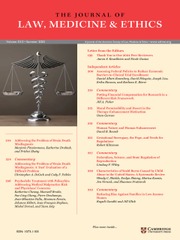No CrossRef data available.
Article contents
FDA Advisory Committee Review of Supplemental Indications and Reasons for Non-Approval, 2008-2022
Published online by Cambridge University Press: 08 April 2025
Abstract
This study characterizes 2008-2022 FDA advisory committee discussions of new supplemental indication applications that were not approved by FDA. Discussion themes included contextual concerns unique to already-approved drugs, including insights from prior experience and concerns about off-label use, and efficacy and safety concerns also observed for new drugs. These findings highlight advisory committees’ role in transparency of regulatory decision-making, specifically for drugs already authorized for use.
- Type
- Independent Articles
- Information
- Copyright
- © The Author(s), 2025. Published by Cambridge University Press on behalf of American Society of Law, Medicine & Ethics


